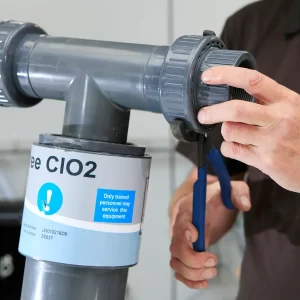Water treatment is a critical aspect of ensuring safe and clean water for various applications, from municipal supplies to industrial processes.
Chlorination has long been a common method, but advancements in water treatment technology, particularly the use of Chlorine Dioxide, have emerged as a superior alternative.
In this post, we explore chloramination, its limitations, and why Chlorine Dioxide, offered by Scotmas, stands out as the optimal solution.
What is Chloramination?
Chloramination involves the addition of ammonia to water that has been treated with chlorine. This process is primarily employed to maintain a more consistent disinfectant residual throughout extended water distribution systems. While chloramination offers certain advantages, such as reduced production of disinfection by-products, it comes with its own set of challenges.
Limitations of Chloramination
1. Formation of Nitrogenous Disinfection By-Products (N-DBPs): Chloramination produces N-DBPs, such as chloramines and nitrosamines, which can pose health risks and regulatory concerns.
2. Limited Efficacy Against Biofilm: Chloramines may struggle to penetrate and eliminate biofilm in water distribution systems, potentially leading to compromised water quality.
3. Ammonia Residual Concerns: Controlling ammonia residuals in chloraminated water is crucial, as excess ammonia may result in taste and odour issues and can compromise water quality.
The Advanced Solution with Chlorine Dioxide
In contrast, Chlorine Dioxide (ClO2) has emerged as a powerful and versatile biocide, offering several advantages over traditional chlorination and chloramination methods.
 1. Superior Biocidal Efficacy: Chlorine Dioxide is highly effective against a broad spectrum of microorganisms, including bacteria, viruses, and protozoa. Its oxidative nature prevents the development of resistance, making it a potent and reliable disinfectant.
1. Superior Biocidal Efficacy: Chlorine Dioxide is highly effective against a broad spectrum of microorganisms, including bacteria, viruses, and protozoa. Its oxidative nature prevents the development of resistance, making it a potent and reliable disinfectant.
2. Minimal Disinfection By-Products: Unlike chloramination, Chlorine Dioxide minimises the formation of harmful disinfection by-products. This is a crucial factor in meeting stringent water quality standards and ensuring the safety of the treated water.
3. Biofilm Penetration: Chlorine Dioxide excels in penetrating and eradicating biofilm, a persistent challenge in water distribution systems. By effectively addressing biofilm, ClO2 ensures sustained water quality and helps prevent issues such as Microbially Induced Corrosion (MIC).
4. Wide pH Range and Environmental Compatibility: Chlorine Dioxide exhibits adaptability to a wide pH range, making it suitable for diverse water treatment applications. Moreover, its environmental impact is relatively low, and it does not contribute to the formation of harmful by-products.
Scotmas Leads the Way in Chlorine Dioxide Solutions
As a prominent player in water treatment solutions, Scotmas stands out for its cutting-edge Chlorine Dioxide systems. Here’s why Scotmas is the preferred choice:
 1. Innovative Technology: Scotmas utilises patented technology for on-site Chlorine Dioxide generation, ensuring efficiency and cost-effectiveness. This breakthrough has made Chlorine Dioxide application economically viable for various water treatment scenarios.
1. Innovative Technology: Scotmas utilises patented technology for on-site Chlorine Dioxide generation, ensuring efficiency and cost-effectiveness. This breakthrough has made Chlorine Dioxide application economically viable for various water treatment scenarios.
2. Tailored Solutions: Understanding that different water systems have unique requirements, Scotmas offers personalised guidance on implementing Chlorine Dioxide strategies. This tailored approach ensures optimal performance in diverse applications.
3. Commitment to Safety and Compliance: Scotmas prioritises safety and compliance in its solutions. The Chlorine Dioxide systems adhere to regulatory standards, providing users with the confidence that they are employing a reliable and safe water treatment method.
Scotmas, with its state-of-the-art Chlorine Dioxide systems, stands at the forefront of this transformation, empowering industries and municipalities to embrace a safer, more efficient, and sustainable approach to water treatment. Please contact Scotmas for inquiries about implementing Chlorine Dioxide solutions or to learn more about Scotmas products and services.






